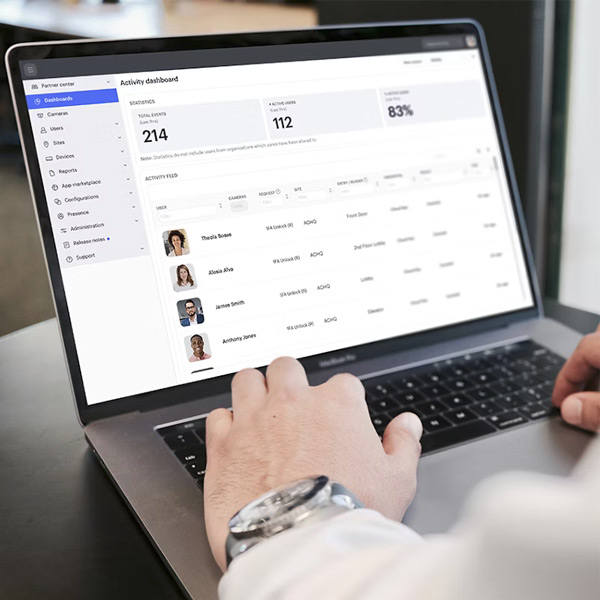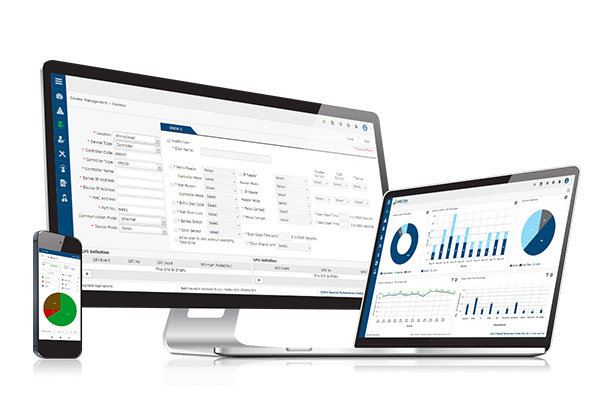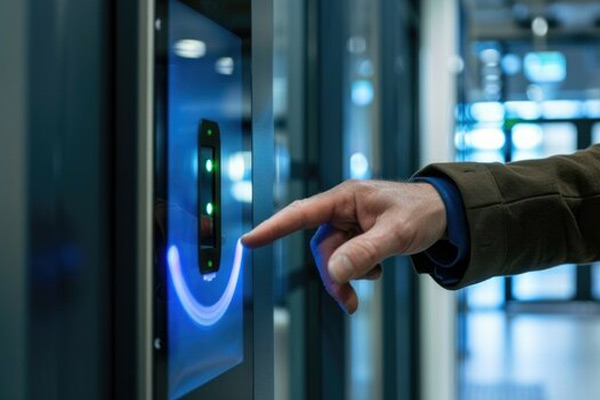Access Control
Secure your business with our best-in-class access control systems.
An effective access control system is essential for regulating movement within your facility. It helps ensure that only authorized individuals can enter specific areas, significantly reducing the risk of unauthorized access, theft, or intrusions. By limiting entry points, they provide an extra layer of protection for sensitive areas within a business.
At Third Eye Technology, we offer a wide range of modern access control systems, from door intercoms and card readers to biometric and facial recognition technologies. Our team will design and install a solution tailored to protect your people, property, and assets.
Comprehensive Solutions for Every Business Size
At Third Eye Technology, we provide tailored access control solutions to fit businesses of all sizes. From single-site systems to fully networked setups for large buildings, our services meet a wide variety of security needs. Each system is customizable, ensuring seamless integration with your operations while providing advanced control over entry and exit points.
Our systems are user-friendly, allowing for easy management of access settings. We also offer comprehensive solutions to manage both pedestrian and vehicle access, enhancing your facility’s overall security.
The degree of complexity of the access control system and alarm systems can be tailored to the end users requirements.
Host Your Solution Your Way
Whether you’re an agile startup or a corporate giant with locations around the country, we customize your solution to suit you.

On-Premises
Enjoy unrivalled visibility and control when you deploy, manage, and maintain your solution within your existing security infrastructure. These systems store data locally, giving you complete control over your access management while ensuring compliance with strict security policies.

Cloud
Enjoy greater flexibility and scalability, with lower upfront costs, automatic backups, and multiple layers of built-in redundancy. By moving access control management to the cloud, organizations gain enhanced flexibility, remote monitoring capabilities, and improved scalability.
Taking Security Into the Cloud
Discover the power of enhanced control, reliability and visibility. Our complete cloud-based access control system is fast, flexible and future-proof with reliable mobile capabilities and intuitive access control software.
Our cloud-based solutions allow you to manage who can access your premises, monitor activity, and update permissions from anywhere, using an intuitive web portal or mobile app. Whether you’re running a single-site operation or managing multiple locations, cloud-based access control keeps your security streamlined and efficient.

The Advantages of an Access Control System

Remote Management
Update permissions, monitor activity, and control access from anywhere—no need to be on-site.

Scalability
Add users, doors, or entire facilities with ease, ensuring your security grows with your business.

Enhanced Security
Data is stored securely in the cloud with encryption, multi-factor authentication, and regular updates to protect against cyber threats.

Cost Efficiency
Eliminate the need for expensive on-site servers and minimize maintenance costs.

Real-Time Alerts
Receive instant notifications about unauthorized access attempts or unusual activity, enabling rapid response.

Seamless Integration
Combine cloud-based access control with other cloud-powered systems, such as CCTV and alarms, for a unified security solution.
Why Choose Third Eye Technology?
At Third Eye Technology, we specialize in designing and installing access control systems that cater to your business’s unique security needs. From conducting a thorough site survey to offering a detailed consultation, our process ensures the right solution for your budget and requirements. Our certified engineers handle the entire installation process, while our expert in-house team customizes the system to fit your specific needs.
When you choose us, rest assured your business, assets, and people are protected with robust, reliable, and future-ready access control systems.. Our in-house, expert design team take each consultation to carefully design each access control system to best meet your specifications within your budget.
Protect Your Business in Four Simple Steps
01
Book a Consultation
Speak with one of our expert consultants to discuss your security needs.
02
System Design
We’ll create a custom access control system tailored to your premises and requirements.
03
Installation
Our certified engineers will install your system, ensuring it integrates seamlessly with your operations.
04
Maintenance
Enjoy the peace of mind that knowing your security system stays fully functional and your premises are protected.
Frequently Asked Questions
What is an access control system?
An access control system is a security solution designed to regulate entry and exit points in a building, room, or area. It allows you to manage who has access to certain areas, ensuring that only authorized personnel can enter. These systems can range from simple keypads and card readers to advanced biometric and multi-door systems, enhancing the security of sensitive spaces.
How does an access control system work?
Access control systems work by verifying the identity of individuals seeking entry through various methods such as keycards, biometrics (fingerprint or facial recognition), or PIN codes. The system then grants or denies access based on predefined permissions stored in its database, ensuring only authorized individuals can enter restricted areas.
How can access control help with safeguarding entry points?
Access control systems safeguard entry points by restricting access to authorized personnel only. By employing various verification methods—such as keycards, biometrics, or PIN codes—these systems effectively prevent unauthorized individuals from entering secure areas. Additionally, access control systems often include monitoring capabilities, enabling real-time alerts and logs of entry attempts, further enhancing the security of sensitive locations.
What types of access control systems are available?
There are several types of access control systems, including:
- Keypad systems: Users input a PIN code for access.
- Proximity systems: Users present a card or fob to a reader.
- Biometric systems: These use fingerprint, facial, or retinal recognition.
- Mobile access systems: Allow entry using smartphones via Bluetooth or NFC.
These can be integrated into larger systems for greater security.
What are the benefits of biometric access control?
Biometric access control systems use unique physical characteristics such as fingerprints or facial recognition to grant access. These systems are highly secure because they rely on unique biological markers that are difficult to replicate. They also eliminate the need for physical keys or cards, making access management more convenient and tamper-resistant.
Can I integrate my access control system with other security systems?
Yes, most access control systems can be integrated with other security solutions, such as CCTV, alarm systems, and intercoms. This allows for a more comprehensive security setup, where the access control system can trigger cameras or alarms when unauthorized access attempts occur.
How can you manage access across multiple locations?
Access management across multiple locations can be streamlined using centralized control software that allows administrators to manage access rights from a single interface. This software can connect to various access control hardware across different sites, enabling uniform access policies. Administrators can easily update permissions, monitor activity, and generate reports for all locations, ensuring consistent security measures are enforced.
Which access control system is right for my business?
Selecting the appropriate access control system is crucial for enhancing security while accommodating the unique needs of your business. Different systems offer varying levels of complexity, scalability, and management options. Here’s a breakdown of the main types of access control systems to help you decide which is best for your organization:
1. Basic or Standalone System
A basic or standalone access control system is an excellent choice for smaller businesses or specific locations that require limited access control. This system typically manages one or two doors and consists of a physical server and a connected computer located on the premises. Its simplicity makes it easy to install and operate, without the complexities of network integration. If your business doesn’t need to connect to other sites, a standalone system provides an effective and cost-efficient solution for securing your premises.
2. Networked System
Networked systems are designed for businesses that operate across multiple locations. This type of system allows two or more access points to be connected, enabling centralized management from a single location with a dedicated data server and networked computers. This flexibility is ideal for organizations with multiple offices, as it streamlines operations and enhances security management. Networked systems provide real-time access logs and enable easy modifications to access permissions across all sites, ensuring consistent security protocols are maintained.
3. Cloud-Hosted System
Cloud-hosted systems take access control to a higher level by outsourcing the management of the access control server to an off-site data center. Physical access devices, such as key card readers, remain installed on-site, ensuring that your operations continue seamlessly. This option is ideal for businesses that prefer to delegate the technical responsibilities of managing their access control systems, particularly those with multiple remote locations. Cloud-hosted systems provide scalability, enabling companies to expand their security measures without the need for extensive infrastructure investments.
How can you determine the level of security needed?
Determining the appropriate level of security requires a comprehensive assessment of your facility’s specific needs. Factors to consider include the nature of your business, the value of assets to protect, the sensitivity of information, and the level of risk for unauthorized access. Engaging with security professionals can help you evaluate these factors and design a customized access control solution that balances security and convenience.
What happens if there is a power failure?
Most access control systems are equipped with battery backups or connected to a building’s uninterruptible power supply (UPS) to ensure continued operation during power outages. In the event of a prolonged failure, many systems have fail-safe or fail-secure modes to either keep doors locked or unlocked depending on your security preferences.
How scalable are access control systems?
Access control systems are highly scalable and can be designed to fit the specific needs of any organization, whether it’s a small office or a multi-building campus. You can start with a basic system and expand it as your security needs grow, adding new doors, users, or even integrating it with other security measures.
How do I manage and update access control permissions?
Access control systems typically come with user-friendly software that allows administrators to easily add, update, or revoke permissions. This can often be done remotely, enabling real-time updates to ensure that access is granted or denied based on current roles or employment status.
Are access control systems GDPR-compliant?
Yes, many modern access control systems are designed to be GDPR-compliant, ensuring that personal data such as biometric information is securely stored and processed in accordance with privacy regulations. Always ensure that the system you choose adheres to the latest data protection guidelines.
